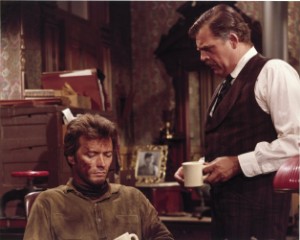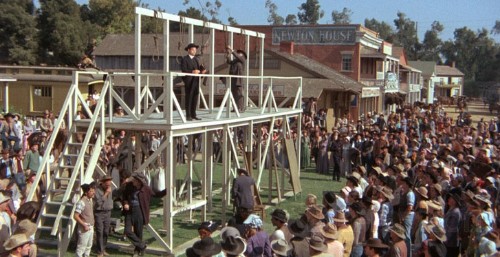
“How many men are you gonna have to hang to heal your scar?”
Hang ‘Em High (1968)
Directed by Ted Post
Written by Leonard Freeman and Mel Goldberg
114 minutes, Rated M
It should be noted that while I do believe very strongly in the wonderment of an audience experiencing a movie’s twists and turns on their own, these reviews will not shy away from spoilers if they are necessary to discussion of the film.
Quick rating: 4/5
In the very first scene of this movie, we see Jed Cooper (played by Clint Eastwood) wade into a river to help a calf that is struggling in the water. Attempts to make the calf move on its own are for naught, so Cooper picks the calf up and carries it to shore. This is important because it shows compassion.
Before this film, Eastwood’s only real films of note were The Dollars trilogy, three films in which he didn’t really play the good guy. He wasn’t a particularly bad guy, but he wasn’t really a hero. In those films, The Man With No Name was more of an anti-hero, the protagonist of the story, but still fairly immoral. He killed and swindled and performed every duty with self-serving purpose. Those movies were Italian art-house films. In America, we like our good guys and bad guys more clearly defined.
This movie goes to great lengths in the first half hour to separate the shoot first, ask questions later persona of The Man With No Name in the Italian films from a new image more palatable to sensitive American audiences. In Hang ‘Em High, Eastwood’s return to American cinema after Leone’s trilogy made him a box office draw, his character treats animals well. His actions are acts of vengeance, necessary after he is accused of a crime that he definitely did not commit. But before he commits these acts of vengeance, he signs up to be a United States Marshall, ensuring that his crimes are acts of sanctioned law. There are distinct differences between a mysterious, immoral vigilante and a law-abiding officer whose motivations are clear and relatable.
 Hang ‘Em High centers around a coincidence and a misunderstanding that turns deadly violent. The aforementioned rescued calf is one of many cattle purchased by Jed Cooper. As he herds them to a new location, he is accosted by a posse of men who demand to see receipt for the purchase. Jed soon learns that the person who sold him the cattle was actually a ruthless rustler who murdered the cattle’s owner and then posed as a legitimate businessman. Naturally, the posse (led by Ed Begley) believes that Cooper is the rustler that did the murdering, so they lynch him and escape with a few of his belongings. Unbeknownst to the posse, Cooper does not die in this lynching. Instead he is rescued from certain death by U.S. Marshall David Bliss (played by Ben Johnson), who takes him to the nearby town of Fort Grant, where the territorial Judge Fenton (played by Pat Hingle) quickly determines that Cooper’s story is the truth. Fenton releases him. He fears, however, that Cooper will enact bloody vigilante revenge on the men who tried to kill him, so he offers him a job with the U.S. Marshall Service. An agreement is made that Cooper is free to round up his adversaries, but he must bring them alive to Fort Grant for proper justice on the gallows of the town square.
Hang ‘Em High centers around a coincidence and a misunderstanding that turns deadly violent. The aforementioned rescued calf is one of many cattle purchased by Jed Cooper. As he herds them to a new location, he is accosted by a posse of men who demand to see receipt for the purchase. Jed soon learns that the person who sold him the cattle was actually a ruthless rustler who murdered the cattle’s owner and then posed as a legitimate businessman. Naturally, the posse (led by Ed Begley) believes that Cooper is the rustler that did the murdering, so they lynch him and escape with a few of his belongings. Unbeknownst to the posse, Cooper does not die in this lynching. Instead he is rescued from certain death by U.S. Marshall David Bliss (played by Ben Johnson), who takes him to the nearby town of Fort Grant, where the territorial Judge Fenton (played by Pat Hingle) quickly determines that Cooper’s story is the truth. Fenton releases him. He fears, however, that Cooper will enact bloody vigilante revenge on the men who tried to kill him, so he offers him a job with the U.S. Marshall Service. An agreement is made that Cooper is free to round up his adversaries, but he must bring them alive to Fort Grant for proper justice on the gallows of the town square.
This film consists from here almost entirely on subtext. The story takes place in Oklahoma Territory in 1889, a full eighteen years before Oklahoma would be ratified and admitted into the Union. To that end, Fort Grant functions as a county seat of sorts for the entire territory, with Judge Fenton serving as its only judge. Fenton is a tired and busy man, desperate for the government relief of statehood. Almost any decision that he makes is made with the potential of statehood in mind. To the nation, the area must appear to be civilized. If this means executing an innocent man to keep the rabble from rioting, then, so be it.
In the instance central to this film, the innocent man happens to be men, brothers apprehended when Cooper and the local sheriff, Ray Calhoun (played by Charles McGraw), track down Miller (played by Bruce Dern). Miller, who stole Cooper’s wallet during the lynching, is now wanted for murder and castle rustling. There is no evidence to support whether or not the two brothers are in cahoots with Miller, but they are arrested anyway and sentenced to death by hanging, despite Cooper’s insistence that they are innocent of any crimes. All of this feeds a very strong theme about the frailties of capital punishment, more than likely a revolutionary theme for a film in the late 1960’s.
The filmmakers should be applauded for not allowing their anti-capital punishment subtext to distract from the story. If anything, the subtext builds Eastwood’s character and makes him even more likable. Cooper is conflicted about his involvement in this execution, creating a catch-22 for our hero. He does not want to work for a man who would allow the execution of innocent men, but he cannot get revenge on his adversaries without the aid of the Marshall’s office, lest he end up on the gallows himself. What is ultimately more important, vengeance or justice? How can the two co-exist when they are so obviously not the same thing?
In my opinion, Hang ‘Em High is one of the better early Eastwood westerns, superior in some ways even to the Dollars trilogy. It’s nice to see Clint’s character so vividly defined. It’s refreshing to have such important subtext take second stage to the plot in a more subtle manner. A better-than-average screenplay can be thanked for this phenomena. It moves very fluidly from plot point to plot point without much digression. Scenes that, at the time, seem superfluous– such as one early sequence where David Bliss guns down Prophet (played by an unrecognizable Dennis Hopper) when he resists arrest– all, in the end, help illustrate more graphically the brutality of martial law.
In this regard, there’s one sequence in this film that I have to mention– the very public hanging of the two brothers. It is decreed by Fenton that six hangings will take place at once. It is a public gallows, right in the center of town square, and the citizenry treats the execution like the social event of the century. Marching bands play. Hymns are sung. Refreshments are sold. Children are hoisted onto their parents’ shoulders for a better view. The crowd is so large that attendees begin congregating on the rooftops of surrounding buildings. One convict drones a confession of guilt and remorse on and on and on as his fellow executees are hooded and fitted with their nooses. Fenton watches the proceedings from his office window, a spirit hovering over the chaos he has wrought. This sequence is harrowing, stomach-churning, and very well-executed.

If this screenplay has a flaw, it exists in the character of Rachel Warren (played by Inger Stevens). Truly the only female in the movie to have any character development whatsoever, I am confused about her inclusion in this tale. When we meet her, she is scanning the faces of a group of arrested men. Later, we learn that she has requested to view every arrested man because she has spent years searching for a man who raped her. Her sole purpose in this movie beyond that is to serve as a love interest for Jed Cooper. She nurses him back to health after an assassination attempt, comforts him during a rainstorm, and then, eventually, (it is implied) becomes his lover. At the film’s conclusion, though, they have decided to not be a couple. She seems to represent the notion that Cooper’s quest for vengeance is a quest in vain. Ultimately, though, it is just a needless romantic subplot that doesn’t change anyone or add anything to the narrative and its themes. It feels a bit like a contradiction in the film’s attempt to make Jed Cooper likable when he spends portions of the movie attempting to woo a woman who has told him she is uncomfortable with men after having been sexually assaulted. On a more personal level, it is the difference between four and five stars.
 I know. I get it. American audiences need a love interest. The inclusion of one helps make the hero more likable in the eyes of female viewers. Big, bad Clint has a soft spot for a pretty, young blonde. But . . . this pretty, young blonde is damaged for justifiable reasons, she remains so after her tryst with Cooper, and serves no purpose in the grander scheme of story. Cooper’s fling with her, in the long run, feels forced and unnecessary.
I know. I get it. American audiences need a love interest. The inclusion of one helps make the hero more likable in the eyes of female viewers. Big, bad Clint has a soft spot for a pretty, young blonde. But . . . this pretty, young blonde is damaged for justifiable reasons, she remains so after her tryst with Cooper, and serves no purpose in the grander scheme of story. Cooper’s fling with her, in the long run, feels forced and unnecessary.
Despite this, there is a lot to love in this film. The action sequences are taut. The character development is top-notch. The screenplay poses questions that have no easy answers, represented best by the film’s final shot, in which our hero heads off into the sunset to track down his next target despite his misgivings about the man he works for. Maybe justice and vengeance are the same thing. Perhaps one becomes easier if the other is your excuse.
Don’t forget the use of great character actors in this film. Alan Hale Jr. (The Skipper) as a bad guy! Terrific!
You nail it on Inger Stevens. Her part in the film and subplot is superfluous. I much more likr yhe relation between Eastwood and prostitute Arlene Golonka. Eastwood also has beyter chemistry with Golonka than Stevens.
I believe this is also thr first pairing with director Don Seigal
LikeLike
Incorrect, old friend. The first pairing with Don Siegel is “Coogan’s Bluff”.
LikeLike